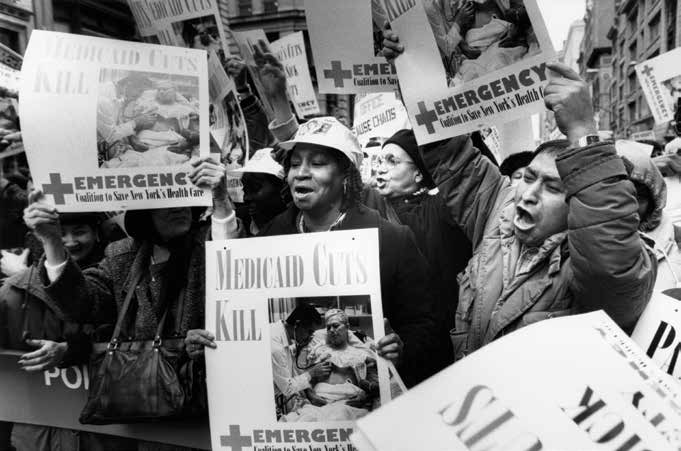Medicaid Promotes Social Justice
February 15, 2024

The “Great Society” programs that advanced civil rights.
"Of all the inequalities that exist the injustice in health care is the most shocking and inhuman,” Dr. Martin Luther King, Jr. stated in the 1960s. Dr. King added that the health care system was a clear example of the denial of civil rights.
In 1963, some 1,000 members of 1199 boarded trains to attend the March on Washington for Jobs and Freedom. In the following two years, Congress passed, and President Lyndon Johnson signed, some of the most important bills in our nation’s history. Chief among them were the Civil Rights Act, the Voting Rights Act, and the Medicare and Medicaid Act.
It’s no coincidence those landmark bills addressed both health care and civil rights. The two are inseparable. Civil and voting rights were designed to grant full citizenship to all. Medicare and Medicaid were meant to provide seniors and the poor their human right to quality health care.
Title VI of the Civil Rights Act protects persons from discrimination based on race, gender, religion, sexuality, national origin, disability, and age in all programs that receive federal funding.
Medicare insurance covers seniors. It is paid for through two U.S. Treasury trust fund accounts. Enrollees also pay a monthly premium. Medicaid provides health insurance for adults and children with limited income. Medicaid is jointly funded by federal and state governments, but primarily managed by the state. It is by far the largest source of health care funding for people of low income. Medicaid along with the Children’s Health Insurance Program (CHIP) cover some 40 million of the nation’s children.
With the passage of Medicare and Medicaid, the financial landscape for hospitals shifted in the late 1960s from fee-for service and philanthropic contributions to federal funding. As a result, the Union campaigned for adequate funding. 1199’s lobbying campaigns did not separate the needs of members from the human rights issues of quality care and full access for all.

The Union Constitution states: “Thus, together with our partners in the healthcare industry, and our friends in our communities, we can build a political environment that can expand access to affordable quality care to everyone and work to create a more healthy—and a more just—society for all.”
In the late 1980s, 1199 leveraged its growing political clout to emerge as a major protector of health care in New York State. Home Care, the Union’s newest and fastest-growing division at the time, depended almost entirely on Medicaid dollars.
The Union’s lobbying and demonstrations targeted both Democratic and Republican administrations. For example, on March 14, 1989 some 7,000 members rallied in Albany, NY to successfully prevent Democratic Gov. Mario Cuomo from slashing the state Medicaid budget by $310 million.
Exactly six years later, some 30,000 members marched down Manhattan’s Fifth Ave. to successfully block Republican Gov. George Pataki’s proposed Medicaid cuts.
During the 1990s, management at the League of Voluntary Hospitals and Homes also joined hands with 1199 in its lobbying efforts. 1199 News reported that during the decade, the Union had forced Albany to back down on more than $11 billion in proposed Medicaid reductions.
The Union also used its political clout in Washington. In 1997, Vice President Al Gore helped direct an additional $1.25 billion in Medicaid dollars to the state.
In 1999, the Union and the Greater NY Hospital Association strengthened their cooperation and their outreach to civic and religious leaders when they jointly formed the Health Care Education Project (HEP). HEP’s mission is to protect and expand access to quality, affordable healthcare for all Americans through education, advocacy, and coalition building.
The organization conducts education and advocacy efforts on critical health care issues. The work of HEP continues to win major budget fights in the 21st century. Each victory means that more patients, particularly from traditionally underserved communities, have access to care.
The obstacles to quality care and their connections to economic and civil rights came sharply into focus in the campaign to defeat and subsequently repeal the 2010 Affordable Care Act (ACA). A key element of the ACA is the expansion of Medicaid in any state that accepts ACA funds.
To date, 10 states have refused to expand Medicaid eligibility under the ACA. Eight of the 10 are Southern “right-to-work” states with poor records of defending civil rights.
A March 2023 study by The Commonwealth Fund found that under the ACA: “Insurance coverage rates improved for Black, Hispanic, and white adults between 2013 and 2021. The coverage gap between Black and white adults dropped from 9.9 to 5.3 percentage points, while the gap between Hispanic and white adults dropped from 25.7 to 16.3 points. Asian Americans and Pacific Islanders also increased coverage.
It is now time to go one step further, which is why 1199 recently launched the Medicaid Equity campaign to ensure that New York State reimburses institutions who serve Medicaid patients at the same rate as commercial insurers do—a model which we must advocate for nationwide.

